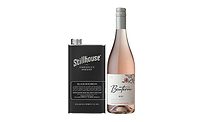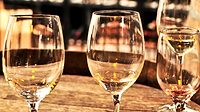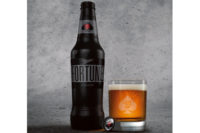Wine and Spirits Continue to Soar
Spurred by growing popularity among younger consumers and numerous flavored product introductions, 2004 was a good year for distilled spirits. And the trend should continue for the next 10 years, during which world consumption of spirits will increase by 20 percent in terms of volume and by 22.5 percent in terms of value, reports the 2005 International Wine & Spirits Record (IWSR) study, The World Wine and Spirits Market with Outlook to 2008.
The overall spirits category has exhibited positive
growth trends of 4.7 percent, driven by increases across all sub-categories
except gin and Scotch whisky (-0.1 percent and -0.9 percent, respectively).
Future growth opportunities lie in flavored and super-premium spirits, with
the latter being the fastest-growing market, reports Information Resources
Inc.
| Top ten still light wine consuming countries (VOLUME — million hectoliters) | ||||
| Country | 1999 | 2003 | Volume %Change |
Share of world wine consumption in 2003 |
| France | 32.23 | 29.04 | -9.9 | 13.9% |
| Italy | 25.18 | 26.59 | 3 | 12.7% |
| Germany | 19.69 | 21.63 | 9.8 | 10.3% |
| USA | 18.11 | 21.50 | 18.7 | 10.3% |
| Argentina | 12.75 | 12.09 | -5.2 | 5.8% |
| United Kingdom | 8.74 | 10.71 | 22.5 | 4.8% |
| Spain | 11.09 | 10.11 | -8.8 | 5.1% |
| Romania | 5.23 | 4.91 | -6 | 2.3% |
| Portugal | 4.28 | 3.92 | -8.4 | 1.8% |
| South Africa | 3.23 | 2.98 | -7.8 | 1.4% |
| Total | 201.12 | 208.17 | 3.5 | 68.4% |
| Source: Vinexpo/ The IWSR 2005 | ||||
| U.S. wine consumption, 1999-2008 | |||
| Wine consumed by volume, excluding rice/fruit wines, fortified wine, light aperitifs (millions of hectoliters) | |||
| Still light wine | Sparkling wine | Total | |
| 1999 | 18.10 | 1.42 | 19.52 |
| 2003 | 21.49 | 1.17 | 22.66 |
| 2008 | 27.66 | 1.36 | 29.02 |
| STILL LIGHT WINE CONSUMED BY ORIGIN (Millions of HECTOLITERS) | |||
| Domestic wine | Imported wine | Total | |
| 1999 | 14.90 | 3.20 | 18.10 |
| 2003 | 16.10 | 5.39 | 21.49 |
| 2008 | 19.33 | 8.33 | 27.66 |
| Still light wine retail turnover (billions of dollars) | |||
| Domestic wine | Imported wine | Total | |
| 1999 | $10.72 | $3.21 | $13.93 |
| 2003 | $11.37 | $5.40 | $16.77 |
| 2008 | $15.88 | $8.33 | $24.21 |
| Still light wine consumed by price point (millions of hectoliters) | |||
| Less than $5 | Between $5-10 | More than $10 | |
| 2003 | 11.13 | 7.91 | 2.45 |
| 2008 | 14.43 | 10.29 | 2.94 |
| Source: Vinexpo/ The IWSR 2005 | |||
Vodka holds the biggest share of the total spirits
earnings pie, tallying 27.6 percent of sales. Vodka is followed by North
American whiskey and rum, with 21.6 percent and 13.3 percent of sales,
respectively. In terms of dollar sales change vs. a year ago, Irish whisky
ranks as the biggest mover and shaker (+13.7 percent), followed by vodka
(+8 percent) and rum (+7.4 percent).
Of the new product introductions, more than 43 percent
of items were concentrated within the vodka and rum categories, IRI
reports. The past year has witnessed the introduction of numerous flavored
vodkas and rums, approximately 36 of 58 new items, notably Malibu Mango and
Pineapple flavored rums, Captain Morgan Parrot Bay Mango and Pineapple
flavored rums and Smirnoff Watermelon and Strawberry Twist flavored vodka,
all extensions of already popular sub-brands. An interesting side note:
Smirnoff Twist flavors account for five of the Top 10 selling flavored
vodkas and 50 percent of the flavored vodka share.
| Global spirits sales (millionS of dollars) | |||
| Subsector | 2004 | Forecast 2005 |
|
| Whisk(e)y | $60,900.9 | $61,764.4 | |
| Brandy and Cognac | $25,148.4 | $25,889.6 | |
| White spirits | $49,474.8 | $51,506.8 | |
| Rum | $20,550.6 | $21,757.5 | |
| Tequila (and mezcal) | $8,230.5 | $8,824.8 | |
| Liqueurs | $28,659.7 | $29,769.8 | |
| Other spirits | $61,190.4 | $63,797.8 | |
| Total | $254,155.2 | $263,310.7 | |
| Source: Euromonitor International, 2005 | |||
Consumers are also taking a keener interest in wine.
Global wine volume increased by 1.9 percent in 2004 to total 26.4 billion
liters, Euromonitor International reports in The
World Market for Wine. Global wine value sales
in 2004 rose by 10.9 percent to total $222.4 billion.
A key factor in double-digit value growth in 2004 was
price inflation due to the shortage of wine in the market in correlation to
poor grape harvests around the globe. A second driving factor was the
consumer trend toward trading-up. Increased sales of champagne in 2004
testified to this trend, while mid-priced New World wines were increasingly
substituted for cheaper domestically produced products in major
wine-producing regions such as Western and Eastern Europe and North
America, Euromonitor reports.
Two factors also inhibited value growth in 2004,
however. The increase in private label sales through supermarkets and
discounters in developed markets, and the significant drop in value sales
in Japan (-15.4 percent between 1999 and 2004), Euromonitor says. The
popularity of good quality “value” brands such as Bronco
Wines’ Charles Shaw also posed a challenge to manufacturers of
premium types of wine. This challenge is expected to increase during the
next three years as the plentiful grape crush of 2004 floods the global
market with inexpensive wine.
Wine sales in the United States from domestic and
foreign producers grew 4 percent to 668 million gallons in 2004, reports
the Wine Institute. The estimated retail value of wine shipments to the
United States is $23.2 billion. Of the total, table wine amounted to 590.5
million gallons; dessert wine was 47.5 million gallons; champagne and
sparkling wine, 30 million gallons, the Wine Institute says. California
wines account for a 64 percent share of the U.S. wine market, or about two
of every three bottles sold.
Wine volume in U.S. supermarkets grew 2.7 percent in
2004 over the previous year, while the value grew 5.1 percent, according to
ACNielsen. For the first time in recent history, red wine edged out white
by volume in food stores. Red held a 40.5 percent market share; white, a
40.4 percent share; and blush a 19.1 percent share of the case volume.
All wine price segments are experiencing growth, and
according to forecasts by IWSR, wines sold for more than $5 a bottle will
represent 47.8 percent of the total volume consumed in the United States by
2008. Between 2003 and 2008, wines in the $5 to $10 price segment should
increase the most (+30 percent), while those sold for less than $5 a bottle
should witness new and significant growth after a period of decline.
IWSR also reports that the United States is poised to
become the leading consumer of still light table wines by 2008. Americans
are projected to drink more than 2.7 billion liters of still light wines by
2008, catapulting volume consumption ahead of Italy and France to the top
position.
U.S. wine exports, 95 percent of which are from
California, surged to $794 million in winery revenues in 2004, a 28 percent
jump over the previous year, according to figures released by the U.S.
Department of Commerce. Exports exceeded the previous year by $173 million
– by far the largest yearly increase ever. By volume, exports
increased 29 percent to 119 million gallons (450 million liters.)
| Global wine sales (millionS of dollars) | |||
| Subsector | 2004 | Forecast 2005 |
|
| Still light grape wine | $151,222.4 | $156,322.5 | |
| Sparkling wine | $29,541.2 | $30,549.0 | |
| Fortified wine and vermouth | $14,309.2 | $14,250.4 | |
| Non-grape wine | $24,859.4 | $23,799.1 | |
| Total | $219,932.2 | $224,921.0 | |
| Source: Euromonitor International, 2005 | |||
The top market for California wine is the United
Kingdom, which experienced a strong 41 percent increase in revenues to
nearly $300 million and a volume jump of 20 percent to 38 million gallons.
The other leading markets are: Canada, $123.8 million; the Netherlands,
$85.6 million; Japan, $82.1 million; Germany, $26.8 million; Mexico, $14.5
million; Switzerland, $14 million; Denmark, $14 million; Ireland, $13.9
million; Belgium/Luxembourg, $13.4 million.
The weaker dollar has allowed California wineries to
better compete at key price points in the world export market, says the
Wine Institute. Nearly one in every seven bottles of wine consumed in the
United Kingdom now comes from the California, and the Wine Institute
reports that exports to the European continent (excluding the United
Kingdom) reached a record 10.6 million cases in 2004. Packaged California
table wine brands account for most of the sales, which, along with other
U.S. table wine exports, total $592 million, up 19 percent. BI




